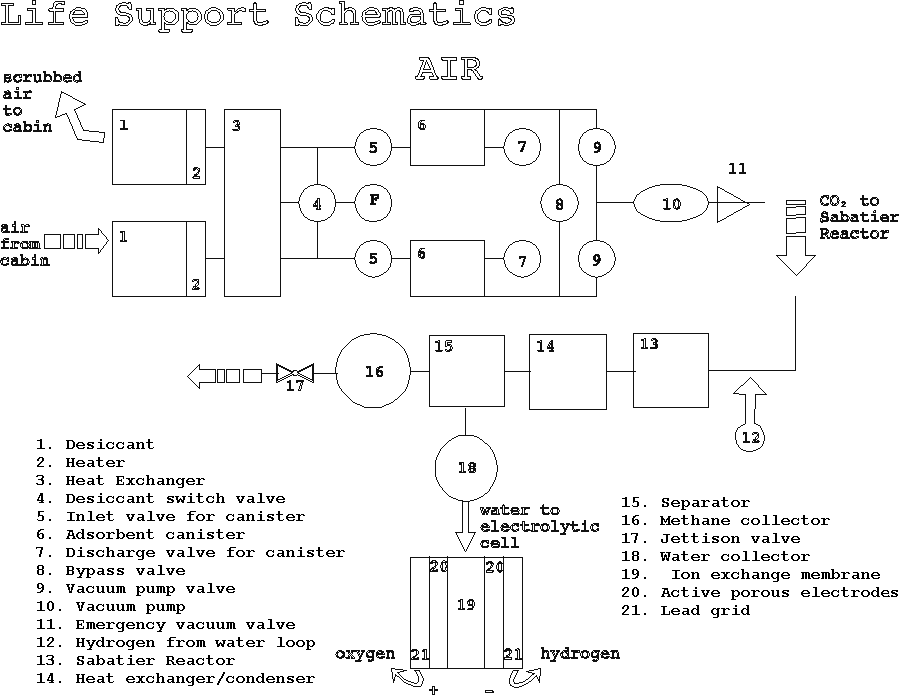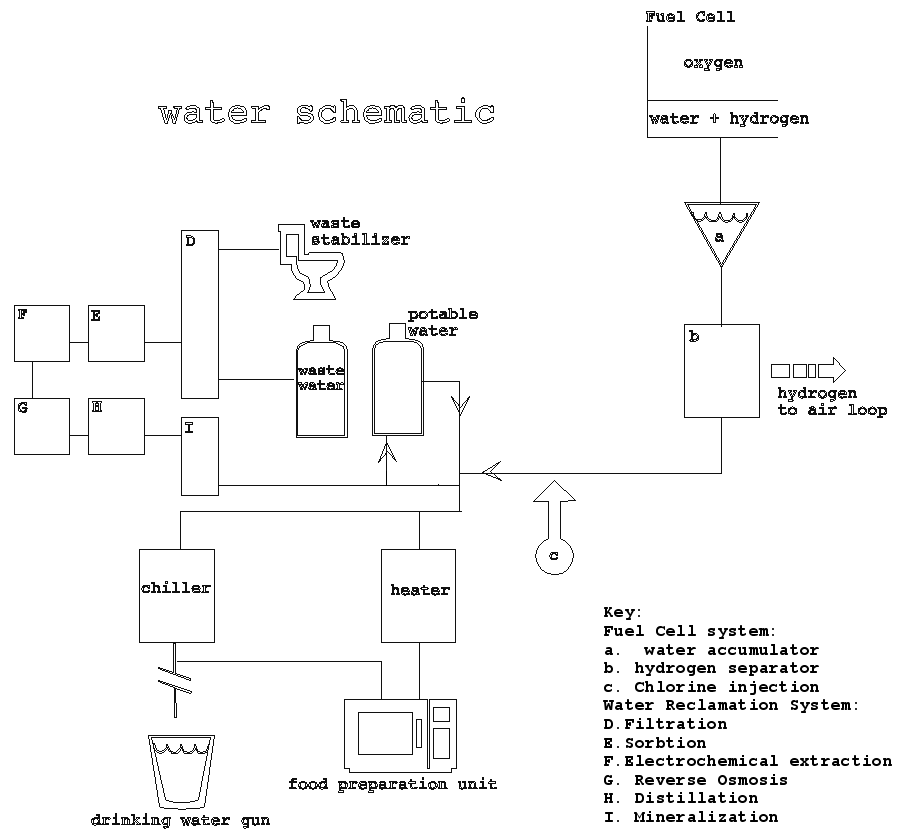Life
Support
Air,
Water, and Nutrition
Waste
Management
Mental
Health
Suits
Radiation
and Zero-G
Astronauts consume a mean value of .98 kg of O2 per day, producing .8 L of CO2 for every liter of O2that they breathe. On previous space missions, the air supply has simply been brought along, the O2 stored in pressurized tanks and the CO2 expelled without any form of oxygen regeneration or carbon dioxide utilization employed. For longer missions like ours, this method of bringing stored oxygen and expelling the used carbon dioxide is not only impractical, it is implausible. Instead, the air supply must be derived from regenerative methods involving the adsorption, concentration, and conversion of CO2 to water, which can then undergo electrolysis to form breathable O2 and H2 which can be used to replenish fuel cells. The system consists of 2 parts: Regenerable liquid adsorbents and Sabatier reactor and electrolysis cell.
Liquid Adsorbents
This aspect of the air regeneration system
works much like the CO2 scrubbers used in spacecraft today.
The scrubbing system consists of regenerative adsorbents which remove the
CO2 circulating cabin air (Fig.6, 179). For the purposes of
this mission, the adsorbents used will be solid amines, which are based
on silica gels and solid amino acid compounds, which may be regenerated
by heating to temperatures above 373 K, which does not put stress on the
power supply. After the cabin air is circulated through the adsorbent system,
scrubbed of CO2, and returned to the cabin, the CO2
will be collected with a vacuum, compressed, and stored in a tank for use in the Sabatier reactor.
Sabatier Reactor
The Sabatier reaction, CO2
+ 4H2 --> CH4 + 2H2O , occurs between
523-573K with a nickel catalyst. The production of water and methane is
of great use for oxygen regeneration, as the water will be electrolyzed
to form oxygen and hydrogen and the methane can either be easily expelled
or used as fuel or in other ship processes. The Sabatier reaction is thermodynamically
stable, and does not require any power to mantain its temperature, making
it practical from a power standpoint as well as a chemical one. The only
disadvantage to this system is that hydrogen must be continually supplied
because of the loss to methane during the reaction. This, too, can be practically
overcome by using the hydrogen removed from the hydrogen-rich water produced
by the fuel cells, closing the cycle.
Air Regeneration Schematic

Water
Each astronaut should consume 2.2-2.5 liters of water per day. To supply the astronauts with this water, a combination of water synthesis and reclamation will be used.
Water Synthesis
Water will be synthesized by the fuel cells
powering both the habitat and the spacecraft. Each fuel cell will
supply 3.78 kg of water per hour. The fuel cells generate hydrogen-rich
water which must be passed through silver-palladium tubes to create potable
water. The excess hydrogen then goes on to assist in the regeneration of oxygen
in the air loop.
Water Reclamation
Because the chemical compositions of human
wastes and water contaminants are so complex and varied, the water reclamation
system must be able to employ many methods to convert waste water into
potable and wash water.
The steps of water reclamation are:
StabilizationWater Reclamation Schematic
Waste Removal
Mineralization
Preservation

Nutrition
An astronaut needs about 0.63 kilograms (dry weight)
of food per day; this amount may vary depending on the activity level at which he
is operating. The breakdown is as follows: 63% of the energy is
to be provided by carbohydrates, 25% from fats, and 12% from proteins.
The energy provided by each group is, respectively: 4.1, 9.3, and 4.1 kCal
per gram. It follows that, when given the number of required KCal (calculated
based on the activity levels of the astronauts), the mass per day of food
can be calculated using:
m=(.63/4.1)x+(.25/9.3)x+(.12/4.1)x
where m is the mass (in grams) of the food and x is the number of required calories.
On this mission, the food will be provided primarily through freeze dried and rehydratable foods. In other words, we are bringing EVERYTHING with us. Although growing plants in space is plausible, that method of feeding astronauts cannot yet be relied upon, although we should perform experiments that would help us explore the possiblity of growing plants in space on future missions. Rehydratable food takes up little space, and can be rehydrated using the water generated by fuel cells.
Some menus from past Russian and US missions:
Metabolic and Nutritional Needs in Space
Typical daily menu of a Soyez cosmonaut Breakfast: Canned meatloaf, bread, chocolate sweets with nut praline, coffee with milk, prune juice
Lunch: Canned beef tongue, bread, prunes with nuts
Dinner: Caspian roach, bortsch, canned veal, rich pastry, black currant juice
Supper: Cream cheese with black currant puree, candied fruit, black currant juice
Now, for contrast...The typical menu of an Apollo astronaut: Breakfast: Apple sauce, sugar frosted flakes, bacon squares, cinnamon toast, cocoa, orange drink
Lunch: Beef with vegetables, spaghetti with meat, cheese sandwhich, apricot puding, gingerbread
Dinner: Pea soup, tuna salad, cinnamon toast, fruit-cake, pineapple-grapefruit drink.
Metabolic Requirements
Past research has shown that caloric requirements in space do not differ significantly from those on Earth - ranging from 1910 to 3576 kCal/day. There is a shift in the source of caloric energy, however, and this must be accounted for in designing a nutritional plan for long-term space flight. There is an observed loss of lean body mass and weight, and analysis of astronauts' waste shows a negative nitrogen balance. These two factors are evidence that the astronauts source of caloric energy has shifted from food intake to catabolism of tissue protein. This can be counteracted with regular exercise and regulation of diet.
Other effects on diet include:
Selected References:a shift in diet from lipids to carbohydrates decreased thirst (due to fluid shift) decreased appetite (due to gastrointestinal responses to weightlessness)
Sulzman, F.M., Genin, A.M. (Ed.) (1993) Space Biology and Medicine, v.2 Life Support and Habitability. Washington, D.C.: American Institute of Aeronautics and Astronautics.
Huntoon, Carolyn S. Leach, Antipov, Vsevolod V., Grigoriev, Anatoliy I. (Ed.) (1993) Space Biology and Medicine, v.3 bk.2 Humans in Spaceflight. Washington, D.C.: American Institute of Aeronautics and Astronautics.
Shipman, Harry L. (1989) Humans in Space: 21st Centure Frontiers. New York: Plenum Press.
Harding, Richard. (1989) Survival in Space: Medical Problems of Manned Spaceflight. New York: Routledge.